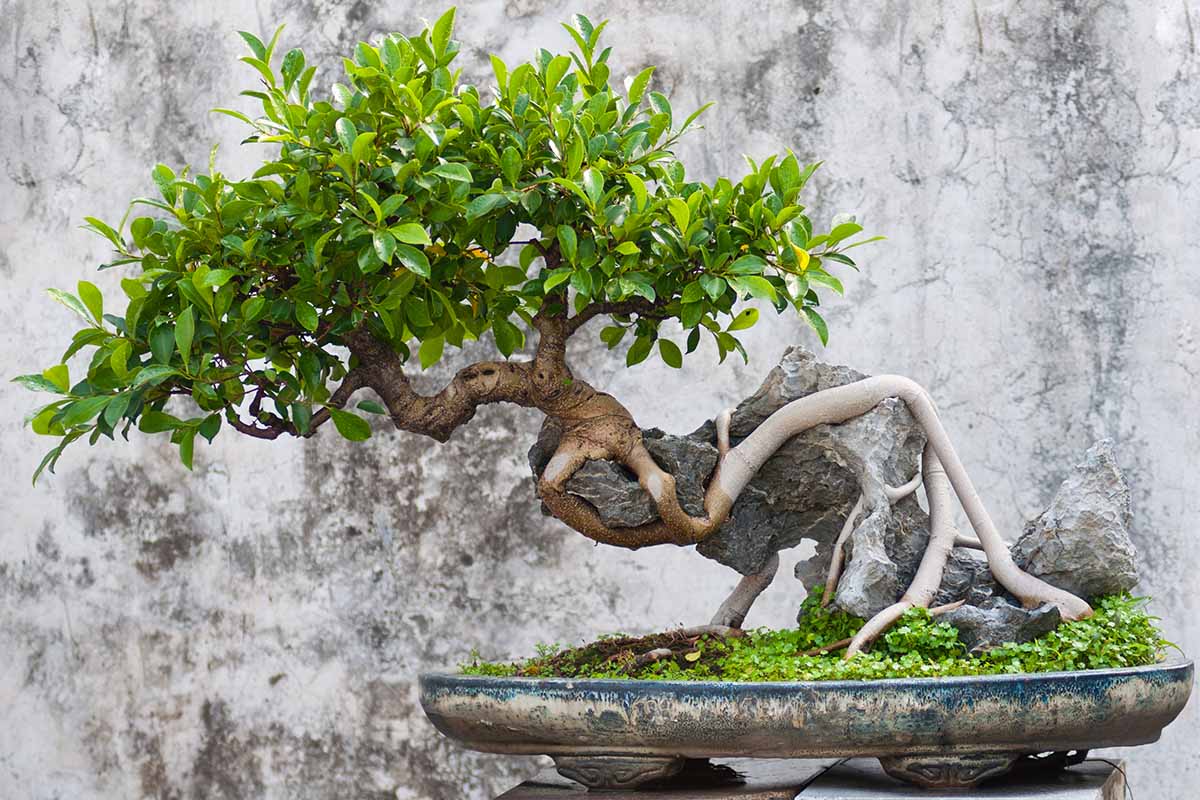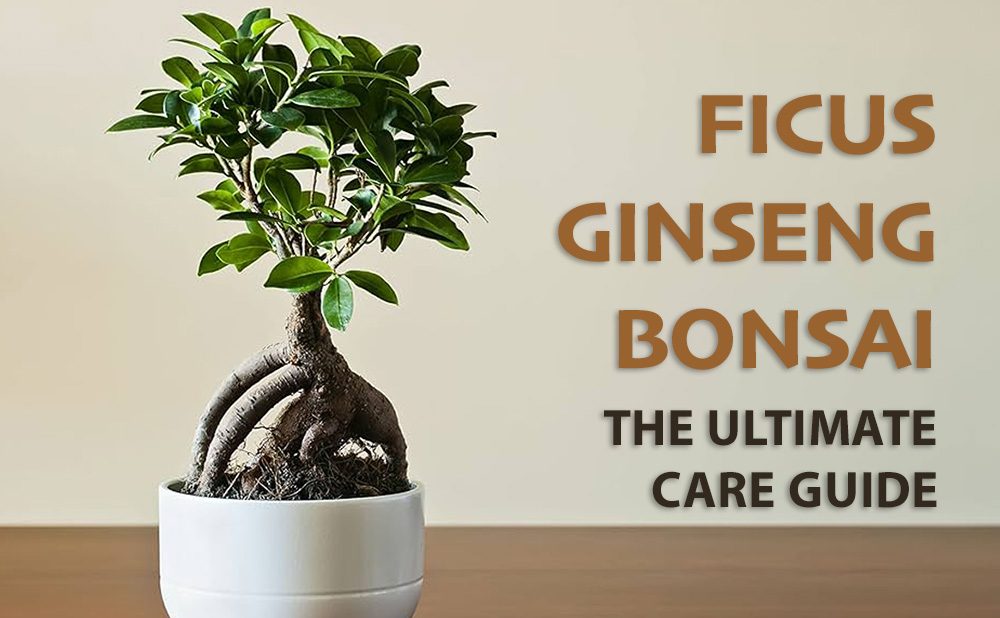- No products in the cart.
If you’re venturing into the traditional Japanese practice of Bonsai, consider beginning with a Ficus Ginseng bonsai. This type of bonsai stands out for its low maintenance needs and resilience, making it an excellent choice for beginners intimidated by the complexities of other bonsai plants.
Native to the tropical regions of Southeast Asia, the Ficus Ginseng is a member of the Moraceae or Mulberry family. This plant is particularly striking with its unique structure: narrow roots that rise and bulk into a potbellied trunk, tapering at the branches and spreading into a lush crown. Bonsai enthusiasts often emphasize these elevated roots to sculpt a distinctive aesthetic. In their natural environments, these aerial roots thrive in high humidity, requiring an artificial enclosure to mimic these conditions when grown indoors. These roots stretch vertically from the branches, descending to the soil where they thicken into robust trunks. This growth pattern is essential for achieving styles like the pillar or the root-over-rock bonsai, known as deshojo.
Remember, bonsai cultivation is an art form that thrives on personal expression—there are no fixed rules as long as the plant remains healthy. However, it’s important to handle the Ficus Ginseng Bonsai with care as its sap is toxic to humans and can cause skin irritation or allergic reactions. Make sure to wash your hands every time you handle the plant. Additionally, keep in mind that this bonsai is also harmful to pets; ensure it is placed out of reach to prevent dogs and cats from chewing on the leaves and becoming sick.

Ficus Ginseng Care
Cultivating and caring for a ficus ginseng bonsai can be straightforward when you adhere to some basic principles. Don’t shy away from this profoundly satisfying art form over concerns about its difficulty.
Lighting
When it comes to lighting, your bonsai requires substantial light. Ideally, place it on a windowsill where it can bask in natural sunlight. If natural light is insufficient, consider using plant lights. During summer, if you move the bonsai outdoors, ensure it occupies a sunny spot as it cannot thrive in shaded areas.
Soil
The soil for your ginseng ficus should consist of sixty percent aggregate and forty percent organic matter. You have the option to purchase a premixed soil or create your own blend with ingredients like pine bark, lava rock, and akadama, which retains water and gradually decomposes.
Watering
Regarding watering, thoroughly moisten the soil of your ginseng ficus whenever it begins to dry out slightly. Regular misting is beneficial, but avoid overwatering to prevent any fungal issues. In warmer settings, your bonsai may require more frequent watering.
To maintain the cleanliness and health of the leaves, wipe them with a damp paper towel when they accumulate dust or mist them with a spray bottle.
Temperature and Humidity
As for temperature and humidity, the ginseng ficus, being an indoor bonsai, does not withstand frost. It can be placed outdoors once temperatures consistently exceed 60°F (16°C). Although it can handle low humidity thanks to the waxy coating on its leaves, it thrives in more humid environments.
Fertilizer
Fertilization is crucial since bonsais have limited soil resources. Use any general-purpose liquid fertilizer from a local nursery or garden center, diluting it by fifty percent with water and applying it monthly.
Pruning
Pruning is essential to maintain the bonsai’s form and not just let it grow as a regular plant. You might skip pruning for a year or more to allow the trunk to thicken. Once you decide to prune, a good practice is to cut back to two leaves after every six to eight leaves have grown. If you’ve allowed the trunk to thicken, expect new shoots to sprout from the old wood. Be sure to address any significant cuts with cut paste to prevent diseases and always use sharp, clean tools for pruning.

Propagating a Ficus Ginseng Bonsai
Propagating your Ginseng Ficus, also known as ficus retusa, is a straightforward process, especially after a pruning session. Here’s how to do it:
- First, identify a healthy stem and use scissors or pruning shears to take a 6-inch cutting.
- Next, place this cutting into a container filled with a prepared potting soil mix. After planting, water the cutting.
- To enhance rooting, cover the cuttings with a clear plastic bag, creating a greenhouse effect that helps retain moisture.
- Ensure the soil remains moist by watering lightly every few days. You can expect the cutting to establish roots within a few weeks.
Potting and Repotting Ficus Ginseng Bonsai
Repotting your Ficus Ginseng bonsai becomes necessary when its roots completely fill the pot, as this procedure refreshes the soil and promotes a denser root system.
You should repot your ficus every other year, ideally during the summer. Start by gently removing the tree and its soil from the pot. Next, trim the outer and lower quarter of the tree’s roots, taking care not to cut away excessive root material. After pruning the roots, place the bonsai back into its original pot or transfer it to a new one, filling it with a bonsai-specific soil mix.
Training Ficus Ginseng Bonsai
To effectively train your Ginseng Ficus bonsai, opt for anodized aluminum or annealed copper wire. The ficus’s thin and medium branches, known for their flexibility, easily bend when wired. However, ensure that the wires do not cut into the tree; adjust them as necessary.
For training larger branches, you will need to use guy wires, which must remain on the tree for an extended period. A fascinating aspect of ficus trees is their ability to fuse branches, roots, and even with other ficus plants, allowing for some stunning and creative formations. Enjoy the process of shaping your bonsai!
Common Pests and Diseases
Proper care of your Ficus Ginseng bonsai, including appropriate lighting and watering, will strengthen it and enhance its resistance to pests and diseases. Spider mites, scale, mealybugs, and aphids might infest the Ficus Ginseng. You can manage these pests using neem oil or a mixture of liquid dishwashing soap and water. Overwatering the plant can lead to fungal diseases and root rot. If you notice white or black spots on the leaves, promptly trim these affected areas and treat the bonsai with a fungicide to prevent further damage.

